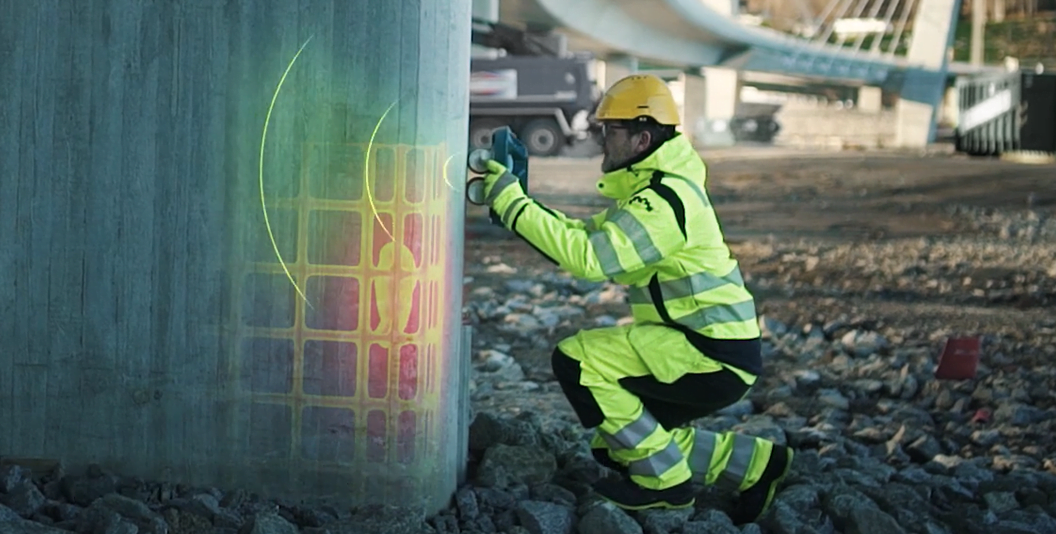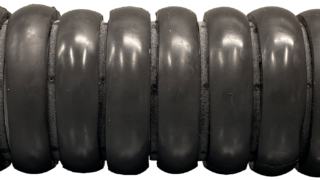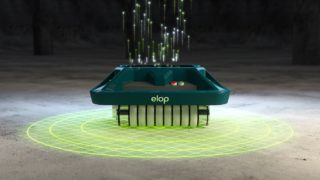When construction companies are handing over new bridges, tunnels or wind turbine foundations to asset owners, inspections are carried out to document that the requirements have been met. Everything is under scrutiny – except for the concrete. With the arrival of the ELOP Insight scanner, that is changing.
While other parts of, let’s say, a newly built tunnel and its steel framework, electrical installations, emergency exits etc., are put under the microscope, the sub-surface condition of the concrete has avoided inspection. Why? Because up until recently, you couldn’t look below the concrete surface in a feasible and efficient way. Therefore, hidden weaknesses were allowed to go undetected.
That has changed with the arrival of the ELOP Insight, the world’s first rolling, dry coupling, ultrasonic scanning solution for concrete inspection. This new inspection tool will change the way a project handover is done, and by providing data about the actual condition of the concrete from its birth, the asset owner can repeat the tests and compare the data over time to monitor any changes. This can reduce maintenance cost and prolong the asset’s lifetime.
Waiting to happen
Buried beneath the concrete’s surface, there can be accidents waiting to happen. Over time, small deficiencies like cracks and air pockets can evolve into problems that will be expensive to fix, and ultimately could compromise the whole structure.
For instance, when you build a railway tunnel, you drill or blast your way through the mountain. Then you construct the tunnel by assembling prefabricated pieces of concrete liner. You must also fill the space between the concrete liner and the mountain surface with concrete. If that isn’t done properly, it will leave behind voids and air pockets, which might risk being filled with water causing leakages into the tunnel. Water will compromise rebars over time. Furthermore, as water expands when it freezes, it will damage the tunnel’s concrete liner. This escalates over time and requires expensive maintenance and repair work.
No requirements yet
Today, there are no requirements for inspecting concrete with ultrasonic techniques before the handover of a project. The reason according to Niklas Persson, Head of Global Sales at ELOP Technology, is that there haven’t been any tools available to carry out sub-surface concrete inspection in a feasible way. Conventional static point scanners are difficult and time consuming to handle. With such equipment, it would take months to inspect a railway tunnel with a length of 10 or 15 km.
- When it comes to steel, you have very precise rules and regulations in place for inspections and non-destructive testing. With concrete that’s not the case. Regarding concrete, people have thought, well, we don’t have the tools to do an efficient inspection, so there is nothing we can do.
- The ELOP Insight scanner changes that completely. We can measure the thickness of the construction, detect and size any cracks, air pockets, or honeycombs, and tell if the rebars are where they should be. Our scanner can roll across the concrete surface and deliver continuous 3D footage of its sub-surface condition. It produces more precise and detailed imagery, and on top of that, it’s much faster than conventional ultrasound tools. That means we can scan the critical parts of a long railway tunnel in a matter of days.
Change is coming
According to Niklas, gone are the days when concrete could avoid inspection at project handover, due to insufficient inspection tools. The ELOP Insight scanner will finally allow for concrete inspection at the same level of detail that is required for other parts of a newly built asset.
Now concrete engineers, construction companies, asset owners and not least technical inspection companies need to be informed of the abilities of the ELOP Insight scanner. When they realize its potential, Niklas is convinced that ultrasound inspection will soon become a requirement in the handover of large concrete assets.
Webinar about project handover
To spread the word in the construction and inspection business, ELOP is preparing a webinar about the abilities of the ELOP Insight rolling ultrasound scanner. The webinar will focus on how the scanner can improve project handover by delivering in-depth data about the concrete’s sub-surface condition. And that goes for a wide range of applications of concrete-intensive infrastructure.
- For instance, offshore wind turbine foundations can be scanned for flaws while they’re still onshore. That will reveal any deficiencies that could propagate and lead to problems later, when the turbine is in operation out at sea. At that time, it becomes extremely difficult and expensive to fix things that could easily have been taken care of earlier.
- When it comes to newly built bridges, the post tension tendon ducts are critical parts of the construction. After stressing the wires, the tendon ducts are filled with concrete or grout. But it can be difficult to fill them completely. There may be voids left, where water can penetrate, which then accelerates corrosion, especially in warm and humid climates close to salt water.
According to Niklas, these are just a few examples of how in-depth insight into the condition of concrete can make a significant difference and therefore should be integrated into the handover of new projects. Knowing the actual state of the concrete from the very beginning will increase the lifetime of the asset, lower the cost of maintenance, prevent accidents, and reduce CO2 emissions.
The webinar about how the ELOP Insight ultrasound scanner can change the testing of concrete before project handover is scheduled for the beginning of March.
Click below to register for our webinar on the 10th March
For more information, please reach out to
Niklas Persson, Head of Global Sales at ELOP Technology,
Email: [email protected]




